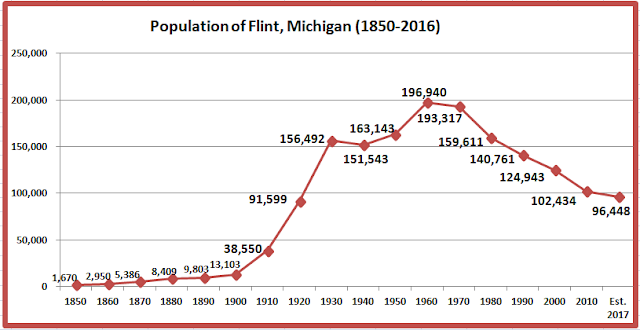Flint's 2022 estimated population decreased 1.7% since the 2020 census. Its population is down 61% since its 1960 peak of 196,940. The city has as many residents now as it did 100 years ago.
Source: Wikipedia
Iosco County News-Herald, 3/30/2023
Long gone are the years of booming growth, like the 1950s, when the population increased close to 2% every year. Outside of a small surge in the 1990s, population growth has been slowing ever since. And the national decline in population growth has been accompanied by another trend: the loss of tens of thousands, sometimes hundreds of thousands, of residents every decade in some of the nation's largest cities.
There are, in fact, several cities that were once among the nation's biggest metropolises and have become shadows of their former selves, due in large part to job losses and demographic shifts.
One such city is Flint, Michigan. Now home to 80,628 people, Flint's population declined by 82,515, or 50.6%, since 1950, when its population totaled 163,143. Over that period, the city went from the 60th most populous in the United States to the 438th.
1/22/2022 update starts here
What used to fuel Flint's economy
The Herald Palladium, 7/4/1999
After 95 years of making Buicks in the city where General Motors Corp. was born, the automaker is shutting the sprawling auto plant and ending 1,300 jobs. It's both the end of an era for a place that has defined the city's identity for nearly a century, and the start of more uncertainty for an already wobbly economy.
"There are not a lot of jobs around here that pay $17 an hour, or $20 an hour, like GM does," says Raymond Faris, the owner of Faris Furniture & Jewelry in downtown Flint.
GM's roots in the city 57 miles north of Detroit date to 1903, when a Flint wagon company bought David Dunbar Buick's struggling gasoline engine shop. The first Buick built in Flint came out the next year, little more than a buggy's frame bolted to a 21-horsepower engine and a steering wheel, with a love seat stuck on top.
Buick became the top seller in 1908, even outselling Ford Motor Co. That same year, owner William C. Durant merged Buick and several other automakers to form GM. GM employed more than 75,000 in the Flint area as recently as 1978, and a large sign at the edge of town welcomed motorists to Buick City.
Original 1/7/2019 post starts here
While store cashiers are nowhere near extinct, the automation of labor is silently wiping out thousands of existing jobs across Michigan — and it's poised to grow.
Analysis by Bloomberg of data from the Bureau of Labor and Statistics suggests that jobs with the highest risk of automation are lower-paying service jobs. Some restaurants, for instance, have begun to phase out wait staff and cooks in favor of iPads and kiosks. A total (though unlikely) shift in the industry would take 379,500 jobs in the state. Receptionists, also on the decline, account for 31,230 Michigan workers. And one day, self-driving cars could eliminate the need for truckers, taking the jobs of 53,040 Michigan residents.Flint's population is now approaching its 1920 census level.
Source: Wikipedia
Flint's population peaked at 196,940 in 1960. Its 2017 estimated population is 96,448 -- a drop of 100,492, or 51%.
Source: Wikipedia
Flint is the largest city in and county seat of Genesee County, where the population peaked at 450,449 in 1980. Its 2017 estimated population is 407,385, a drop of 9.6 %. The county 's population is 74.5% white.
Related reading:
Many Flint Residents Are Desperate to Leave, but See No Escape. (The New York Times, 2/6/2016)Flint was a city on the precipice long before its water crisis. In some respects, it resembles a miniature Detroit, marked by unemployment, blight and violent crime. Neighborhoods are pockmarked with abandoned homes, front doors missing and windows smashed. “No Metal” is scrawled in spray paint across some of the empty houses, a message meant to deter thieves looking for steel or copper to sell for scrap.
The auto plants that once made this a booming middle-class city have mostly closed. In 1960, nearly 200,000 people lived here; now, fewer than half that do.Here's how Flint went from boom town to nation's highest poverty rate. (mlive, 9/21/2017)
"You saw the white flight starting in the early 1960s and I think that just strengthened it and made them leave faster. That has eroded the middle class and the higher class people in the city of Flint - leaving this large group of unemployed and people living in poverty."
The disappearing cities:
Baltimore, Maryland. (12/31/2018)
Cairo, Illinois. (1/5/2019)
Cleveland, Ohio (1/2/2018)
Detroit, Michigan. (1/1/2019)
Gary, Indiana. (1/4/2019)
Johnstown, Pennsylvania. (1/6/2019)
St. Louis, Missouri. (1/2/2019)







No comments:
Post a Comment